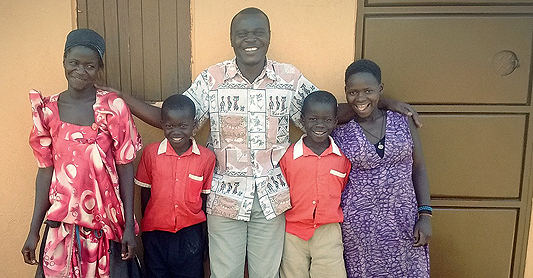
FAQ
What is it that you do?
We work with families in desperate housing need in rural Uganda to help provide safe, secure family homes and opportunities to improve household income. We also prioritise family health through improved sanitation, hygiene and drinking water facilities.
How do you do it?
We work on a very simple model whereby beneficiary families contribute to their home build project, generally through labour or other practical means, while funding is provided by I AM through UK fundraising events, partnerships and collaborations.
How long does it take?
A typical home build project, which not only provides a home but also solar lighting, drinking water, cooking facilities, bathroom facilities, and an agricultural plot, takes around five months from breaking ground to the day the family moving in.
Who qualifies for assistance?
Our primary focus is to offer assistance to families or individuals living in crisis, in desperate housing need; qualified either by virtue of being practically homeless or living in conditions that are an immediate threat to their health and safety.
How do you assess benefactors?
Our operations manager, who lives in the community, is keenly aware of the circumstances of potential benefactors. Following his low-key assesments on the ground, the whole team meets to make some initial decisions and prioritise cases as deemed fit.
How is the benefactor involved?
During the home build project, part of our agreement with home build partners requires them to contribute practically. The form of this contribution is assessed on a per case basis but is most usually in the labour itself or other practical support of the build team.
A Home - A Hope - A Future
Is this an aid project?
The honest answer is yes and no. The initial investment (funding) has far reaching impact, in particular on prospects and opportunities, beyond the immediate provision of housing and an agricultural plot. It’s a step up that will enable real lasting and long-term change.
Do you mortgage the properties?
Our work meets the immediate needs of our benefactor families. Even then, with very limited resources, the expectation that costs could be recovered through a mortgage is unrealistic and would counter the benefit gained from the investment of both parties.
Is there ongoing support?
In the year proceeding moving in, our operations manager makes several informal visits with benefactors. In some cases this will be in support of ongoing vocational training facilitated by the charity, but often is an opportunity to listen to concerns and offer advise.
Is what you do sustainable?
Our goal is to meet the needs of our benefactors without compromising the needs of future generations. Providing access to clean water and sanitation, renewable energy, access to education, reduced poverty & hunger and opportunity for economic growth.
How are projects funded?
All our funding comes from donations. For our home build projects we have adopted a ‘family ties’ model whereby a group, or an individual, commit to raising the full funds for a home build over a maximum period of six months.
Where do you work exactly?
We’ve been invested in the villages of Kisimula & Kadunda, in the Nakaseke region of central Uganda, since the early 2000s. Having developed good relationships over decades, it made sense to continue working amongst communities we know so well.
